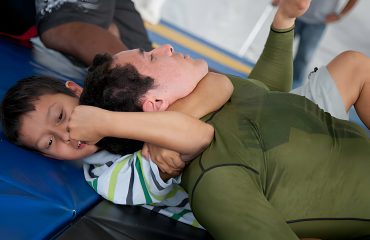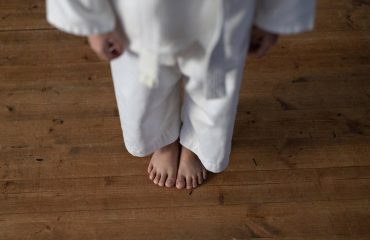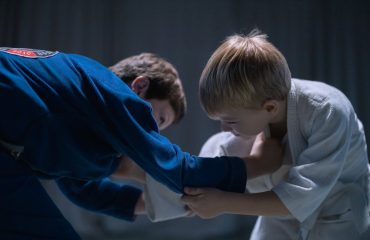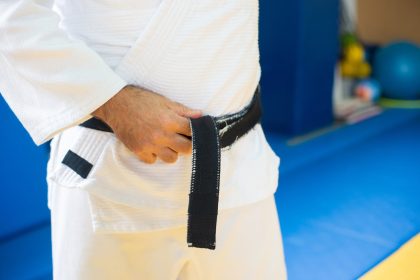
The path to earning a black belt in Brazilian Jiu-Jitsu is one of profound personal growth, discipline, and mastery of the art. At NOCO Jiu-Jitsu and Self-Defense, we guide our students through this enriching process with a philosophy that emphasizes not just the physical aspects of Brazilian Jiu-Jitsu but also the mental and emotional growth that comes with it. Achieving a black belt is a significant milestone that represents years of dedication, learning, and overcoming challenges. It’s a path we are deeply committed to supporting every step of the way.
Understanding the Belt System in Brazilian Jiu-Jitsu
The belt system in Brazilian Jiu-Jitsu is a structured progression that marks a student’s advancement in knowledge, skill, and technique. Adults can advance through the belt ranks in this sequence: white, blue, purple, brown, and black. Each belt consists of 5 stages, starting with a plain belt followed by 4 stripes. These stripes can be earned based on duration, understanding, conduct, and performance in competitions. Starting from white and moving through blue, purple, brown, and finally black, each belt signifies a new level of proficiency and understanding. The black belt, however, is more than just a rank; it’s a symbol of expertise, dedication, and a deep understanding of Brazilian Jiu-Jitsu’s principles and techniques.
The progression through the belts in Brazilian Jiu-Jitsu is not just about physical prowess but also about mental growth, discipline, and the cultivation of a respectful attitude toward both the art and its practitioners. Each belt color represents a step forward in the practitioner’s progression, with specific skills, techniques, and philosophies to be mastered. As students progress from one belt to the next, they are not only learning new techniques but also refining their existing skills, improving their physical conditioning, and deepening their strategic understanding of Brazilian Jiu-Jitsu. This is how long you can get the black belt. This progression is carefully designed to build a comprehensive and well-rounded martial artist.
Attaining a black belt in Brazilian Jiu-Jitsu holds immense significance, symbolizing a profound dedication to the discipline. It entails years of unwavering commitment, often spanning a decade or more of rigorous training. A black belt signifies mastery, denoting the ability to execute advanced techniques with precision and mentor others. It marks a moment of great pride and achievement, yet also heralds the start of a new phase in one’s path. Beyond personal advancement, it embodies the essence of Brazilian Jiu-Jitsu: mastering the art and passing on knowledge to others.
Setting Realistic Goals on Your Path to Black Belt
In the path towards achieving a black belt in martial arts, setting realistic goals is a fundamental step. This process not only keeps practitioners focused and motivated but also provides a clear roadmap for progress. Understanding the importance of goal setting in martial arts is the first step in crafting a plan that leads to success. It’s about recognizing where you are, where you want to be, and what steps are necessary to bridge that gap. Goals should be specific, measurable, achievable, relevant, and time-bound (SMART), ensuring they guide you effectively toward your ultimate aim.
Tips for setting achievable milestones include:
- Start with Short-term Goals: Break down your path into smaller, manageable objectives. For example, mastering a specific technique or improving your fitness level within a few months.
- Incorporate a Variety of Goals: Include technical skills, physical conditioning, and mental preparation in your objectives. This holistic approach ensures balanced development.
- Seek Guidance from Instructors: Leverage the experience of your coaches to set realistic expectations for your progress. They can provide valuable insights into what milestones are appropriate for your level.
- Celebrate Small Victories: Acknowledge and celebrate each achievement, no matter how small. This reinforces positive behavior and keeps you motivated.
- Adjust Goals as Needed: Be flexible and willing to adjust your goals based on your progress and any new challenges you encounter.
- Keep a Training Journal: Documenting your training, goals, and progress can provide insights into your development and areas needing improvement.
- Set Deadlines: Having a timeline for your goals adds a sense of urgency and can help keep you focused.
- Visualize Success: Regularly visualize achieving your goals. This mental rehearsal can enhance your motivation and confidence.
- Incorporate Feedback: Actively seek and incorporate feedback from your instructors and peers to refine your approach and goals.
- Stay Patient and Persistent: Understand that progress in martial arts is often slow and incremental. Patience and persistence are key to overcoming plateaus and continuing to advance.
By setting realistic goals, martial artists can maintain a clear focus on their path to a black belt. This structured approach to training and development not only enhances motivation but also ensures that practitioners are constantly progressing, overcoming challenges, and refining their skills. Remember, the path to a black belt is as much about personal growth as it is about martial proficiency. Each goal achieved is a step closer to not just a new belt, but a deeper understanding of martial arts and oneself.
The Role of Discipline and Consistency
Discipline and consistency stand as the pillars of success in Brazilian Jiu-Jitsu (BJJ), essential for both the mastery of techniques and personal growth within the martial art. Discipline extends beyond mere attendance, embodying a deeper commitment to learning, applying feedback, and overcoming obstacles with perseverance. It sets a standard of excellence that demands unwavering commitment. Consistency complements this by ensuring sustained effort over time, crucial for developing muscle memory and an intuitive grasp of BJJ’s complex movements and strategies. Together, these qualities not only enhance physical and technical growth but also cultivate mental resilience, preparing practitioners for both competitive and real-world challenges.
Moreover, the impact of discipline and consistency transcends individual achievement, influencing the broader BJJ community by setting a positive example for peers and fostering an environment of mutual growth and support. This collective dedication to regular practice and improvement heightens the overall standard of training, reinforcing a culture where continuous learning and excellence are the norms. Adopting these principles equips BJJ practitioners with the tools for success on the mat, while also instilling life skills that benefit them in all aspects of their pursuit, marking the path toward both personal and communal achievement in the art of Brazilian Jiu-Jitsu.
Mastering the Fundamentals: Key to Progression
Mastering the fundamentals is essential in Brazilian Jiu-Jitsu (BJJ), serving as the foundation for all subsequent learning and advancement within the martial art. Beginning with core techniques and principles such as basic positions (guard, mount, side control) and essential movements (shrimping, bridging, rolling), practitioners learn the language of leverage and control that defines BJJ. This focus on basics ensures a solid groundwork, enabling students to more easily grasp advanced concepts and techniques later in their progression. The principles of leverage, timing, and efficiency are particularly emphasized, teaching students how to control and submit larger opponents, apply techniques at the most effective moments, and conserve energy for sustained effort.
As students dedicate themselves to the fundamentals, they not only enhance their self-defense capabilities but also prepare for a lifelong path of development within BJJ. This strong foundation allows for a deeper exploration of the art’s vast techniques and strategies, making complex aspects more accessible and increasing the practitioner’s ability to innovate and adapt in various scenarios. The continuous focus on fundamentals enriches understanding and execution at every level, ensuring that practitioners can effectively communicate through the art of BJJ and continuously refine their skills as they progress toward mastery.
Advanced Techniques and Strategy
Attaining the black belt rank in Brazilian Jiu-Jitsu (BJJ) marks a noteworthy achievement, representing not only extensive training over the years but also a profound comprehension of the art’s complex aspects. This stage of learning focuses on advanced techniques and strategies, demanding practitioners to showcase not just technical skills but also a strategic mindset that distinguishes them. The advanced concepts encompass diverse positions, transitions, submissions, and counters, requiring a nuanced grasp of BJJ principles.
Integrating these advanced techniques into your training demands a deliberate approach. It involves a combination of rigorous drilling, reflective practice, and continuous feedback from experienced instructors. Practitioners at this level are encouraged to develop their unique style, adapting the techniques that best suit their body type, strengths, and weaknesses. This personalization of the art is what makes BJJ so effective and dynamic. As students progress, they learn to not just execute techniques, but to think several moves ahead, anticipating their opponent’s reactions and planning accordingly. This strategic depth is what distinguishes a black belt practitioner, making them not just competitors or martial artists, but true students of the game.
Physical and Mental Conditioning
There is an integral link between physical ability and mental toughness in Brazilian Jiu-Jitsu that enables excellence on the mats. A body honed through conditioning applies techniques exactly and perseveres through demanding matches. Similarly, an unbreakable psyche keeps concentration against opposition, plots strategy under strain, and tackles training and competitions with relentless resolve. We explore methods to build rugged physical fitness and an unyielding mindset – both basic pillars for Brazilian Jiu-Jitsu artists pursuing mastery. Developing these intertwined attributes empowers the execution of skills with accuracy and endurance while focusing under pressure to outlast and outthink adversaries.
To build a strong physical foundation, practitioners must engage in a comprehensive fitness regimen that targets the unique demands of Brazilian Jiu-Jitsu. This includes:
- Strength Training: Incorporating bodyweight exercises and weightlifting to build the muscle strength necessary for grappling techniques.
- Cardiovascular Endurance: Engaging in activities like running, swimming, or cycling to improve heart health and stamina, ensuring practitioners can maintain energy levels throughout lengthy sparring sessions.
- Flexibility Workouts: Regular stretching routines and yoga enhance flexibility, allowing for a greater range of motion and reducing the risk of injuries during training.
- Technical Drills: Practicing specific Brazilian Jiu-Jitsu movements and techniques to develop muscle memory and improve overall agility and technique execution.
- Nutritional Planning: Adopting a balanced diet that fuels the body for performance and recovery, emphasizing proteins, carbohydrates, healthy fats, and hydration.
Parallel to physical conditioning, mental resilience is cultivated through a series of psychological strategies and practices:
- Meditation and Mindfulness: Techniques to enhance focus, reduce stress, and maintain calmness in the face of adversity, both on the mat and in daily life.
- Visualization Practices: Imagining successful execution of techniques and positive outcomes to build confidence and prepare mentally for competition.
- Goal Setting: Establishing clear, achievable objectives to motivate and guide the training process, providing a sense of direction and purpose.
- Stress Management Techniques: Learning to recognize and manage stressors effectively, ensuring they do not impede performance or well-being.
- Cognitive Behavioral Techniques: Adopting positive thinking patterns to overcome self-doubt and fear, fostering a growth mindset that thrives on challenges and learning.
By integrating these physical and mental conditioning strategies into their training regimen, Brazilian Jiu-Jitsu practitioners can build the comprehensive resilience required to excel in the sport. This holistic approach ensures that individuals are not only physically prepared to execute techniques with precision and endurance but are also mentally equipped to approach training, competition, and the challenges of life with confidence, focus, and a positive mindset.
Sparring and Competition: Testing Your Skills
Sparring and entering competitions are essential components of martial arts training that offer numerous benefits. These activities not only test your skills under pressure but also provide invaluable feedback on your progress and areas needing improvement. Engaging in sparring sessions simulates real-life combat situations, allowing practitioners to apply techniques in dynamic and unpredictable settings. Competitions, on the other hand, serve as milestones, challenging individuals to set goals and work diligently towards achieving them.
Getting students ready for competitive settings requires a thorough method covering both physical and mental readiness. Coaches are pivotal in ensuring students have the strategies, skills, and self-assurance for success. This readiness entails diverse training approaches aimed at enhancing overall performance and adaptability in competitive scenarios.
- Technical Proficiency: Ensuring students master the fundamental techniques before advancing to more complex strategies.
- Tactical Awareness: Teaching students to recognize opportunities and threats during sparring or competition.
- Physical Conditioning: Implementing a conditioning program that enhances strength, flexibility, and endurance.
- Mental Toughness: Developing resilience and the ability to stay focused under pressure.
- Strategic Sparring: Organizing sparring sessions that mimic competition settings to acclimate students to the pace and intensity of a real match.
- Video Analysis: Review footage of sparring sessions and competitions to identify strengths and areas for improvement.
- Goal Setting: Encouraging students to set personal goals for their performance in training and competitions.
- Nutritional Guidance: Providing advice on proper nutrition to optimize performance and recovery.
- Recovery Strategies: Teaching the importance of rest and recovery techniques to prevent injuries and maintain peak performance.
- Community Support: Fostering a supportive environment where students can share experiences, strategies, and encouragement.
The experience gained through these challenges is invaluable, contributing significantly to a martial artist’s development. It’s not just about winning or losing; it’s about learning, growing, and pushing beyond perceived limits. Through dedicated preparation and support, students can transform their apprehension into excitement, viewing each match as an opportunity to showcase their skills and hard work.
The Importance of Teaching and Leadership
In the process of mastering Brazilian Jiu-Jitsu (BJJ), the transition from learner to teacher marks a pivotal point in a practitioner’s development. When you begin to teach others, you not only share your knowledge but also deepen your understanding of the art. This process of teaching forces you to examine techniques with a critical eye, breaking down complex movements into understandable segments for your students. This act of deconstruction and explanation reinforces your grasp of the fundamentals, often leading to new insights and a better appreciation of BJJ’s intricacies. Moreover, the responsibility of guiding others encourages a thorough review of one’s own techniques, ensuring that you embody the principles you teach.
Leadership within the BJJ community extends beyond the mat. It involves setting an example of discipline, respect, and continuous improvement. As a leader, your attitude and approach to training can inspire others to pursue their goals with determination and perseverance. This role requires patience, empathy, and the ability to motivate, qualities that are invaluable both in and out of the dojo. Leading by example, you contribute to creating a positive and supportive environment where all members can thrive. The respect you earn as a leader in this community is not just for your skill level but for your ability to uplift others, fostering a sense of unity and shared purpose. Through teaching and leadership, you not only enhance your own BJJ experience but also play a crucial role in the growth and development of those around you, strengthening the community as a whole.
Overcoming Plateaus and Staying Motivated
Overcoming plateaus in martial arts or any discipline involves recognizing these standstills as opportunities for growth rather than insurmountable obstacles. Adjusting one’s training routine, setting new, achievable goals, and focusing on small improvements can help push past these periods of stagnation. It’s essential to view these challenges as chances to deepen one’s understanding and refine skills, which can reinvigorate practice and lead to breakthroughs. Finding motivation during these times is crucial, whether through personal milestones, visualizing success, or drawing inspiration from the achievements of peers, as it drives continued effort and dedication even on the toughest days.
The support of a community plays an invaluable role in maintaining motivation and focus. Being part of a group that shares similar aspirations and faces similar challenges offers a unique sense of belonging and encouragement. This camaraderie within the martial arts community provides not only a support network but also a platform for sharing experiences, and advice and celebrating each other’s successes. Engaging with this community can offer new perspectives and insights, with advice from fellow practitioners or instructors often being the key to overcoming plateaus. Participating in seminars, workshops, and group discussions can introduce fresh approaches and techniques, reigniting enthusiasm and advancing skills.
The Final Push: Preparing for Your Black Belt Test
The road toward earning a black belt is a testament to dedication, skill, and a deep understanding of martial arts. As you approach the pinnacle of this path, the black belt test represents not just a challenge to your physical capabilities but also a test of your mental resilience and preparedness.
Here’s how to ensure you’re ready for this crucial milestone.
Mental Preparation:
- Visualize Success: Spend time visualizing the test. Imagine yourself performing each technique flawlessly, facing challenges with calmness, and ultimately succeeding. This mental rehearsal can boost your confidence and reduce anxiety.
- Set Realistic Goals: Break down the test into segments and set achievable goals for each. Knowing what you aim to accomplish in each part can help focus your preparation and improve performance.
- Embrace Positivity: Surround yourself with positive influences—people who encourage and believe in you. Positive reinforcement can significantly impact your mindset leading up to the test.
- Study and Reflect: Review all materials, notes, and techniques learned throughout your training. Reflecting on your path can reinforce your knowledge and highlight areas needing more focus.
Physical Preparation:
- Intensify Training: Increase the intensity and frequency of your training sessions. Focus on perfecting techniques, improving endurance, and strengthening your body to meet the demands of the test.
- Practice Under Pressure: Simulate test conditions during practice sessions. Performing under pressure can acclimate you to the test environment, making the actual experience less daunting.
- Rest and Recover: Adequate rest is crucial in the weeks leading up to the test. Ensure you’re getting enough sleep and incorporating rest days into your training schedule to allow your body to recover.
- Nutrition and Hydration: Pay attention to your diet and hydration. Eating balanced meals and staying hydrated can significantly affect your energy levels and performance.
Tips for Success:
- Seek Feedback: Regularly consult with your instructors for feedback on your performance. Understanding your strengths and areas for improvement can guide your final preparations.
- Stay Committed: The final weeks before the test can be the most challenging. Stay committed to your training, maintain focus on your goals, and remember why you began this path.
Continuous Learning and Growth Beyond Black Belt
Achieving a black belt in Brazilian Jiu-Jitsu signifies not the end, but the commencement of an advanced phase of learning and skill refinement. At NOCO Jiu-Jitsu, this milestone is viewed as an opportunity for practitioners to explore deeper into the art, focusing on honing their techniques, crafting a distinctive style, and making meaningful contributions to the BJJ community. The path that follows is characterized by an unwavering commitment to personal development and mastery of complex strategies, supported by a curriculum that adapts to the latest advancements in both competitive and self-defense aspects of the sport.
This advanced stage of training encourages black belts to engage in a continuous process of improvement, participating in specialized seminars and competitive events that challenge their abilities and foster growth. The environment at NOCO Jiu-Jitsu is designed to nurture lifelong learning among its practitioners, ensuring that the achievement of a black belt is just one step in a much larger path of martial arts excellence. This approach not only facilitates the personal growth of advanced practitioners but also sets a standard of excellence that motivates the entire BJJ community to pursue their highest potential.
The path to attaining a black belt in Brazilian Jiu-Jitsu is a testament to the strength of perseverance, commitment, and the unwavering pursuit of excellence. At NOCO Jiu-Jitsu and Self-Defense, we pledge to assist you throughout each phase of this endeavor, providing the guidance, expertise, and community necessary for your success. Together, we can enhance your martial arts experience to new levels. Join NOCO Jiu-Jitsu and Self-Defense for tailored support, expert instruction, and a community devoted to assisting you in realizing your full potential. Contact us today to explore our programs and discover how we can contribute to your martial arts aspirations.
